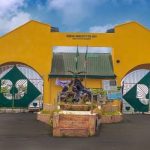Discover the Nasarawa State University cut-off mark for Science Laboratory Technology (SLT) 2025/2026. Learn about departmental cut-off (200), UTME subject combination, O’Level requirements, aggregate score calculation, and admission tips.
Getting admission into Nasarawa State University, Keffi (NSUK) is every student’s dream, especially for competitive science-based courses such as Science Laboratory Technology (SLT). Each year, thousands of applicants apply through JAMB UTME, but only a fraction secure admission. One of the most important admission criteria is the cut-off mark.
Cut-off marks serve as the minimum score required for candidates to qualify for admission into a chosen course. It ensures that only students who meet academic standards are considered for NSUK’s Post-UTME screening and departmental selection.
For prospective SLT students, understanding the NSUK cut-off mark for Science Laboratory Technology is very crucial. Unlike general university thresholds, departmental cut-off marks are often higher because of the competition and limited slots available in science-based programs.
In this guide, we’ll explain:
-
The general JAMB cut-off mark for NSUK 2025/2026.
-
The departmental cut-off mark for Science Laboratory Technology.
-
Required O’Level subjects and UTME subject combination.
-
The aggregate score calculation NSUK uses.
-
Practical tips to score above the cut-off mark and boost your admission chances.
-
A detailed FAQ section for common student questions.
By the end of this article, you’ll have a clear understanding of what it takes to gain admission into NSUK’s Science Laboratory Technology programme.
Department Overview: NSUK – Science Laboratory Technology (SLT)
Founding & Growth
-
The SLT Department at NSUK was officially established following Senate approval on March 26, 2015, and it began admitting students in the 2015/2016 academic session under the leadership of Dr. Gideon A. Amuga from the Department of Zoology
-
Initially comprising four distinct programme options—Biochemistry, Biology, Chemistry, and Physics-Electronic Techniques—the department started with 42 pioneer students
-
Today, the department has grown significantly, accommodating 1,764 active students across its various programme options
Academic Status & Accreditation
-
The department gained interim accreditation in 2019, followed by full accreditation for five years in 2021—a milestone that affirms its academic credibility
-
It’s also noteworthy that NSUK was approved in 2023 by the Nigerian Institute of Science Laboratory Technology (NISLT) as a regional centre for administering the Mandatory Professional Examination (MPE) for science laboratory technologists. The department recorded a 75% pass rate in Module One, with a 100% pass rate in Module Two among re-sit examinees
Programmes Offered
The Department offers a Bachelor of Science in Science Laboratory Technology (B.Sc. SLT) with the following options:
-
Biochemistry Technique
-
Biology Option
-
Chemistry Option
-
Physics-Electronics Option
Faculty Structure & Governance
-
The Head of Department (HOD) leads the department, supported by the departmental board consisting of all academic staff (excluding graduate assistants)
-
Over the years, the position of HOD has been held by several noteworthy academics—from the pioneer Dr. Amuga, through acting heads, to Prof. B.O. Atolaiye becoming the substantive HOD in the 2022/2023 session
Entry Requirements
UTME Entry:
-
Candidates must have five (5) O’Level credit passes, including English Language, Mathematics, Chemistry, Biology, and Physics.
-
The required UTME subject combination: Biology, Chemistry, and either Physics or Mathematics
Direct Entry:
-
Applicants may apply via Direct Entry if they possess:
-
Relevant ND, NCE, or advanced-level qualifications (e.g., A-Levels).
-
A First Class or Second Class (Upper) degree in a related field. Other qualifications deemed equivalent by NSUK Senate may also be considered
-
Faculty & Institutional Context
-
The SLT Department operates under the Faculty of Natural and Applied Sciences, one of NSUK’s foundational faculties since the university’s inception in 2001.
-
The faculty has expanded over time and now includes 11 departments, all offering undergraduate and postgraduate degrees. These programmes are designed to be robust, innovative, and fully accredited by the National Universities Commission (NUC)
Summary at a Glance
| Feature | Details |
|---|---|
| Established | Senate approval in 2015; students admitted from 2015/2016 academic year |
| Programmes | B.Sc. SLT in Biochemistry, Biology, Chemistry, Physics-Electronics |
| Student Growth | From 42 pioneers to ~1,764 active students |
| Accreditation | Interim in 2019; full accreditation in 2021 |
| Professional Recognition | NISLT MPE Centre for North Central Region; strong pass rates |
| Entry Requirements | O’Level credits; UTME (Biology, Chemistry, Physics/Math); Direct Entry |
| Governance | Head of Department and academic staff board |
| Faculty Profile | Part of Faculty of Natural & Applied Sciences; all programmes NUC-accredited |
This overview encapsulates the NSUK SLT Department’s evolution, academic offerings, accreditation status, entry requirements, and institutional context—all backed by official and authoritative sources.
General NSUK JAMB Cut-Off Mark for 2025/2026
The management of Nasarawa State University, Keffi (NSUK) has officially pegged the general JAMB cut-off mark for the 2025/2026 academic session at 170 and above.
This means that any candidate who scores 170 or higher in the UTME is eligible to apply for the Post-UTME screening exercise.
However, this 170 minimum cut-off is only a baseline requirement. For competitive courses such as Law, Nursing, Medicine, and Science Laboratory Technology, the actual departmental cut-off is usually much higher.
Here’s a breakdown:
-
Low-competition courses (e.g., Agriculture, History, Religious Studies) → 170
-
Moderately competitive courses (e.g., Accounting, Political Science, Sociology) → 180–200
-
Highly competitive science/health courses (e.g., SLT, Nursing, Biochemistry) → 200 and above
So, if you scored 170, you are eligible to sit for Post-UTME, but realistically, you will need a much higher score to compete for SLT admission slots.
Departmental Cut-Off Mark for Science Laboratory Technology at NSUK
For the Science Laboratory Technology (SLT) programme at NSUK, the departmental cut-off mark is 200.
This means:
-
If you score below 200, your chances of being admitted into SLT are very slim.
-
If you score 200–220, you have a fair chance depending on competition.
-
If you score 230 and above, your admission chances become very strong.
The reason why SLT has a higher cut-off mark than the general university threshold is because:
-
Limited slots are available for SLT.
-
It is a high-demand science course that attracts applicants nationwide.
-
The department wants candidates who are academically strong in science subjects.
Therefore, while NSUK accepts candidates from 170 upwards, to stand a realistic chance at SLT, you should target 200–250+ in your UTME score.
UTME Subject Combination and O’Level Requirements for SLT
To study Science Laboratory Technology at NSUK, you must meet both UTME subject combination and O’Level requirements.
O’Level (WAEC/NECO/NABTEB) Requirements:
Candidates must obtain at least five (5) credit passes in not more than two sittings, including:
-
English Language
-
Mathematics
-
Biology
-
Chemistry
-
Physics
UTME Subject Combination:
For JAMB UTME, candidates must select the following subjects:
-
English Language (compulsory)
-
Biology
-
Chemistry
-
Physics or Mathematics
This subject combination ensures that candidates have the necessary science foundation for SLT.
How NSUK Calculates Aggregate Score for Admission
NSUK does not rely on JAMB UTME scores alone; it combines UTME + Post-UTME to calculate the final aggregate.
Formula:
-
UTME score ÷ 8 = 50% of aggregate
-
Post-UTME score ÷ 2 = 50% of aggregate
Example:
-
UTME Score: 240 → 240 ÷ 8 = 30
-
Post-UTME Score: 70 → 70 ÷ 2 = 35
-
Total Aggregate = 30 + 35 = 65%
If the departmental cut-off for SLT is 60%, this candidate qualifies for admission.
This is why scoring well above 200 in UTME is important—because it balances your Post-UTME score and increases your admission chances.
Tips to Score Above Science Laboratory Technology (SLT) program Cut-Off Mark
-
Target 250+ in JAMB UTME to stay competitive.
-
Focus on science subjects (Biology, Chemistry, Physics, Mathematics).
-
Use recommended textbooks and JAMB past questions.
-
Attend tutorials or group studies for difficult topics.
-
For Post-UTME, revise current affairs, general knowledge, and subject-specific questions.
-
Always ensure your O’Level result is complete and uploaded to JAMB CAPS.
Frequently Asked Questions (FAQs)
-
What is NSUK’s cut-off mark for SLT in 2025/2026?
→ The cut-off mark is 200. -
Can I study SLT with 180 in JAMB at NSUK?
→ No, you must score 200 and above. -
What is the general cut-off mark for NSUK 2025/2026?
→ The general cut-off mark is 170. -
Does NSUK accept two sittings for SLT?
→ Yes, but only a maximum of two sittings. -
Which UTME subjects are required for SLT?
→ English, Biology, Chemistry, and Physics/Mathematics. -
How many years is SLT at NSUK?
→ It is a 4-year program for UTME candidates, 3 years for Direct Entry. -
Is SLT at NSUK competitive?
→ Yes, it is highly competitive. -
Can Direct Entry candidates apply for SLT?
→ Yes, with relevant A-Level, ND, or HND certificates. -
What is the Post-UTME form fee at NSUK?
→ Typically ₦2,000. -
When will NSUK release Post-UTME forms for 2025?
→ Usually around July–September.
Conclusion
The Nasarawa State University (NSUK) cut-off mark for Science Laboratory Technology in 2025/2026 is 200. While the general university cut-off mark is 170, SLT is highly competitive, requiring higher scores. Candidates should aim for 200–250+ in UTME and perform excellently in the Post-UTME to boost admission chances.
Always remember to confirm details from the official NSUK website before applying.
If you’re interested in other programmes, see the complete NSUK departmental cut-off marks for all courses 2025/2026








Leave a Reply